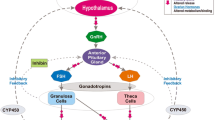Abstract
The distribution of anticonvulsant drug therapy was studied in 318 malformed infants with known histories of maternal epilepsy. Data on the infants was collected from six birth defect monitoring programs in Europe and South America.
Use of specific types of anticonvulsants varies midely among reporting countries. Heterogeneity of drug-malformation distribution, was analyzed to determine whether use of specific drugs were linked to specific malformations. A significant association was seen between maternal use of valproic acid and spina bifida, and a weaker, non-significant one between carbamazepine and spina bifida. Facial clefts were associated with both diphenylhydantoin and phenobarbitone use and also with polytherapy. These differences indicate that the actual drug used is significant for the teratogenic process. The technique may be useful in analyses of other drug-related teratogenic questions.
Similar content being viewed by others
References
BertolliniR., KällénB., MastroiacovoP., RobertE. (1987): Anticonvulsant drugs in monotherapy. Effect on the fetus. - Eur. J. Epidemiol. 3: 164–171.
RobertE., LöfkvistE., MauguièreF., RobertJ.M. (1986): Evaluation of drug therapy and teratogenic risk in a Rhone-Alpes district population of pregnant epileptic women. - Eur. Neurol. 25: 436–443.
BertolliniR., MastroiacovoP., SegniG. (1985): Maternal epilepsy and birth defects: a case-control study in the Italian multicentric registry of birth defects (IPIMC). - Eur. J. Epidemiol. 1: 67–72.
BossiL. (1983): Fetal effects of anticonvulsants. In: Antiepileptic Drug Therapy in Pediatrics, edited by MorselliP.L., PippengerC.E. and PenryJ.K. Raven Press, New York, pp. 37–64.
KällénB. (1986): A register study of maternal epilepsy and delivery outcome with special reference to use. - Acta Neurol. Scand. 73: 253–259.
LammerE.J., SeverL.E., OakleyG.P.Jr. (1987): Teratogen update: Valproic acid. - Teratology 36: 465–473.
Rodriguez-PinillaE., SalvadorJ., AlonsoF.G., Martínez FriasM.L. (1985): Antiepilépticos y malformaciones congénitas: Estudio en una población espanola (1976–1983). - Farmacoterapia 2: 148–153.
Author information
Authors and Affiliations
Rights and permissions
About this article
Cite this article
Källén, B., Robert, E., Mastroiacovo, P. et al. Anticonvulsant drugs and malformations is there a drug specificity?. Eur J Epidemiol 5, 31–36 (1989). https://doi.org/10.1007/BF00145041
Issue Date:
DOI: https://doi.org/10.1007/BF00145041




